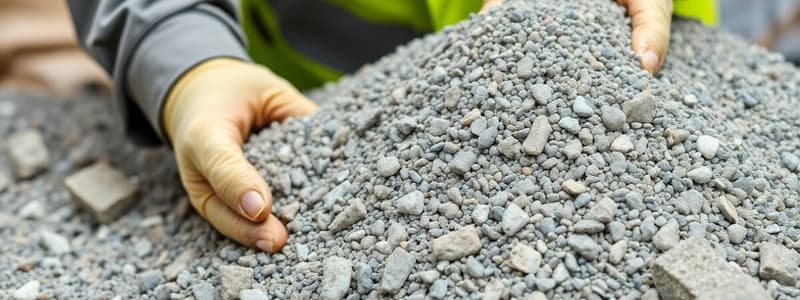Podcast
Questions and Answers
What defines fine aggregates in concrete mixtures?
What defines fine aggregates in concrete mixtures?
- Materials that provide bulk and structural strength.
- Coarse particles that cannot pass through a sieve.
- Materials larger than 3/8 inch.
- Sand and other small particles passing through a 3/8-inch sieve. (correct)
Which property of aggregates is NOT directly related to their effect on concrete strength?
Which property of aggregates is NOT directly related to their effect on concrete strength?
- Color. (correct)
- Unit weight (bulk density).
- Absorption.
- Specific gravity.
What is the purpose of the sieve analysis test in aggregate testing?
What is the purpose of the sieve analysis test in aggregate testing?
- To assess the water absorption capacity.
- To determine the particle size distribution. (correct)
- To measure the toughness and resistance of aggregates.
- To calculate the fineness modulus.
Which class of concrete is preferred for structural components that are heavily reinforced?
Which class of concrete is preferred for structural components that are heavily reinforced?
How is specific gravity of aggregates defined?
How is specific gravity of aggregates defined?
What does the fineness modulus help estimate in concrete mixtures?
What does the fineness modulus help estimate in concrete mixtures?
Which type of aggregate test measures the resistance to wear?
Which type of aggregate test measures the resistance to wear?
The unit weight of aggregates impacts which aspect of concrete mixes?
The unit weight of aggregates impacts which aspect of concrete mixes?
What is the primary purpose of tensile tests in construction materials testing?
What is the primary purpose of tensile tests in construction materials testing?
Which piece of equipment is essential for conducting compression tests on materials?
Which piece of equipment is essential for conducting compression tests on materials?
What does a slump test evaluate in fresh concrete?
What does a slump test evaluate in fresh concrete?
Which property of construction materials refers to their ability to withstand an applied load without failure?
Which property of construction materials refers to their ability to withstand an applied load without failure?
Which test is particularly relevant for assessing concrete beams?
Which test is particularly relevant for assessing concrete beams?
What does ductility in construction materials signify?
What does ductility in construction materials signify?
Which type of test would be most useful to determine how well a material can handle compressive forces?
Which type of test would be most useful to determine how well a material can handle compressive forces?
In construction materials testing, what does toughness refer to?
In construction materials testing, what does toughness refer to?
Flashcards are hidden until you start studying
Study Notes
Comprehensive Reviewer on Construction Materials Testing and Aggregates
Module 1: Introduction to Construction Materials Testing
- Construction materials testing (CMT) ensures materials meet necessary standards for strength, durability, and safety in construction.
- Types of tests performed include:
- Tensile Tests: Measure the material's behavior under tension, assessing its ability to stretch without breaking.
- Compression Tests: Evaluate how materials resist compressive forces, commonly applied to concrete.
- Flexure (Bend) Tests: Assess bending strength of materials like concrete beams and tiles.
- Slump Test: Measures workability of fresh concrete to determine how easily it can be shaped.
- Key equipment includes:
- Universal Testing Machine (UTM): Crucial for conducting tensile, compression, and flexural tests to determine mechanical properties.
- Sieve Set: Determines particle size distribution in aggregates.
- Slump Cone: Measures consistency and workability of concrete.
- Curing Tank: Maintains controlled curing conditions for concrete samples.
- Important properties of construction materials:
- Strength: Ability to withstand loads without failure.
- Toughness: Capacity to absorb energy and deform plastically before fracturing.
- Ductility and Malleability: Ductility allows materials to stretch under tension; malleability permits deformation under compression.
Module 2: Aggregates
- Aggregates are granular materials essential for concrete and asphalt, consisting of fine and coarse particles.
- Types of aggregates include:
- Fine Aggregates: Small particles, like sand, that pass through a 3/8-inch sieve, filling voids and enhancing density in concrete.
- Coarse Aggregates: Larger materials, such as gravel and crushed stone, that contribute bulk and structural integrity to concrete mixtures.
- Key properties of aggregates:
- Unit Weight (Bulk Density): Mass per unit volume, influencing the strength and stability of concrete.
- Specific Gravity: Ratio of aggregate density to water density, indicating relative density.
- Absorption: Measures the amount of water absorbed by aggregates, impacting water requirements in mixes.
- Important aggregate tests include:
- Sieve Analysis: Evaluates particle size distribution to ensure proper grading for concrete mixes.
- Abrasion Test: Assesses toughness and wear resistance of coarse aggregates for construction applications.
- Fineness Modulus: An empirical figure to assist in estimating material proportions in concrete mixes.
- Classes of concrete:
- Class A: Designed for heavily reinforced structural components like beams and columns.
- Class B: Typically used for footings and lightly reinforced elements.
- Class C: Suitable for thinner elements, including slabs, walls, and railings.
Module 3: Universal Testing Machine (UTM)
- UTM evaluates mechanical properties of materials under various loads, including tension and compression.
- Main components include:
- Loading Unit: Comprises the load frame which supports specimens during testing.
- Upper and Lower Crossheads: Clamp the test specimen; the upper crosshead is adjustable while the lower remains fixed.
Studying That Suits You
Use AI to generate personalized quizzes and flashcards to suit your learning preferences.




